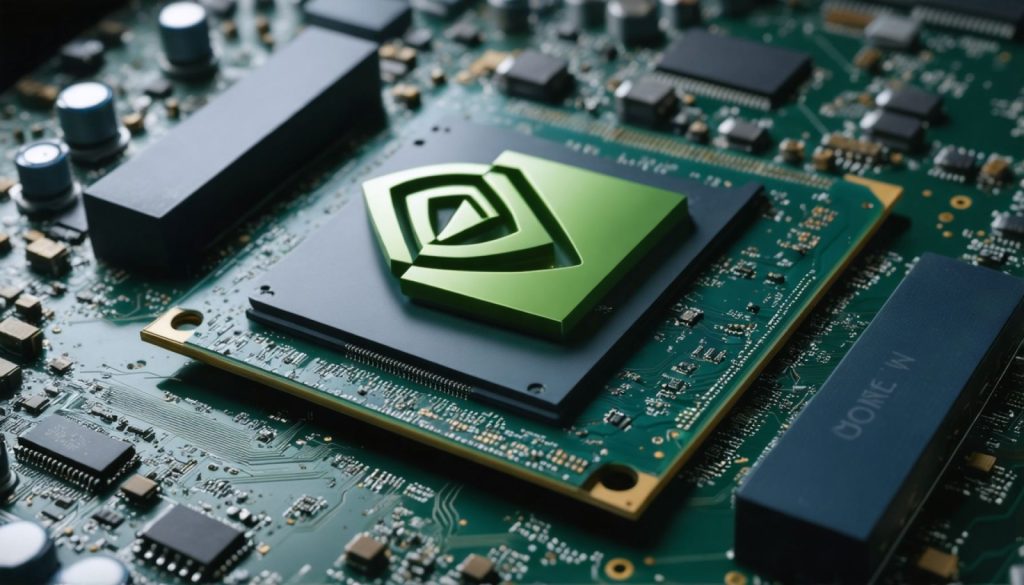
- The US has imposed new export restrictions on Nvidia’s H20 chip to slow China’s AI advancements.
- Nvidia faces a $5.5 billion financial setback, with its shares dropping due to market reactions.
- The H20 chip, critical for China’s AI development, now requires a special export license.
- Nvidia’s growth in China, comprising 13% of its sales, is jeopardized by these restrictions.
- The US aims to limit China’s tech capabilities for military use, echoing a global trend.
- US tech companies worry such curbs may hinder global innovation and competitiveness.
- Further trade restrictions could deepen economic tensions between the US and China.
In a dramatic escalation of the geopolitical chess match over artificial intelligence, the US government has tightened its grip on Nvidia’s H20 chip exports to China, maneuvering to curb China’s accelerating AI advancements. Nvidia, a colossus in the cutting-edge world of AI technology, now stares down a daunting $5.5 billion financial setback. The company’s shares, mirroring the gravity of the situation, plunged as the markets reacted.
The H20 chip, a technological marvel released just last year, was Nvidia’s calculated response to past export limitations. Engineered with agility, it allowed Nvidia to maintain ties with China while skirting around existing US export laws. But even the technologically nimble H20 now demands a special license for export, following the footsteps of its more potent sibling, the H100, which has been off-limits to China.
This chip hadn’t just been a stellar piece of tech hardware—it was the driving force behind DeepSeek’s remarkable R1 AI model, a ChatGPT equivalent that sparked a seismic shift in the AI industry. DeepSeek’s innovative spirit, now igniting waves of inspiration and investment across China’s tech landscape, highlights the broader ramifications of Nvidia’s predicament.
Analysts warn that the financial hit, while significant, could be overshadowed by the strategic hindrance posed by new restrictions. Nvidia’s sustained growth in the Chinese market, which made up 13% of its sales last year, now stands on rocky ground. The fresh licensing rules, part of the US’s broader strategy to halt China’s technological prowess from bolstering its military capabilities, echo a growing international narrative.
For tech giants based in the U.S., the curbs signify more than just restricted sales—they are seen as barriers to global competitiveness and innovation. As AI models continue to evolve, often requiring only modest chip technology to advance, key players fear that this standoff might stifle technological ingenuity and economic growth.
Furthermore, whispers of impending additional trade restrictions signal that this economic tussle is far from over. The Biden administration, much like its predecessor, has swathed ultra-advanced AI technologies in layers of export controls, ostensibly to safeguard national security. Yet, this move is a double-edged sword, slicing into potential advancements within the US as much as it curtails China’s momentum.
Underneath the looming specter of a trade war that threatens to intensify, a vivid scene unfolds: burgeoning AI hubs in China, investment coffers overflowing, and a world watching meticulously. As collaboration becomes entangled with caution and innovation with regulation, this saga demands attention. It’s a tempestuous voyage that underscores a compelling truth: where technology, economics, and geopolitics intersect, the stakes are as high as the ambitions they seek to either fuel or fetter.
US Export Controls on Nvidia: The Unseen Ripple Effects in the AI Landscape
Understanding the Context
The recent US export restrictions on Nvidia’s H20 chip mark another chapter in the ongoing technological chess game between the US and China. This move underscores a broader geopolitical struggle over artificial intelligence, a domain increasingly woven into national security, economic competitiveness, and industry innovation.
Real-World Use Cases Beyond Chips
1. Global Supply Chain Disruption: Nvidia’s H20 chip is not just a piece of silicon; it is a vital element for AI development, especially for companies like DeepSeek in China. The abrupt halt to its export impacts downstream industries reliant on cutting-edge AI for everything from medical diagnostics to autonomous vehicles.
2. Strategic Diversification: With tighter restrictions, companies are diversifying their supply chains and technology tiers. AI companies may now focus on homegrown solutions or seek partnerships with non-US chip manufacturers.
3. Collaborative Setbacks: For researchers and academic institutions, these export controls might hinder international collaboration on AI research projects, potentially slowing down global advancements in this field.
Market Trends & Predictions
– AI Hubs in China: Despite US restrictions, Chinese tech hubs continue to flourish, backed by government incentives and investments. They aim at bolstering domestic tech industries and reducing reliance on foreign technologies.
– Industry Forecasts: Analysts predict a short-term dip in Nvidia’s revenue, but the long-term impact hinges on their ability to innovate further and navigate these restrictions. Nvidia might invest more aggressively in R&D to develop new technologies compliant with export regulations.
The Financial & Innovation Clash
– Financial Impact: Nvidia faces a potential $5.5 billion revenue loss. While significant, Nvidia’s diverse product portfolio and leadership in AI and graphics technology can help absorb the shock.
– Innovation at Risk: The US aims to prevent China’s military advancements, but these controls can backfire, potentially stifling innovation domestically as well. As AI models require less sophisticated technology to improve, the restrictions might inadvertently slow technological progress in the States.
Navigating the Challenges
How-To Navigate Export Restrictions
1. Explore Alternative Markets: Nvidia can expand into regions less impacted by US-China tensions, such as Europe, to mitigate revenue impacts.
2. Invest in Compliance: Developing robust compliance frameworks to easily adapt to evolving export regulations can safeguard against future disruptions.
3. Forge Alliances: Partner with international firms and researchers to foster innovation despite geopolitical barriers.
Pros & Cons of Export Controls
– Pros: Protects national security, slows potential adversaries’ military tech advancements.
– Cons: Hampers domestic growth, risks innovation slowdown, creates market volatility.
Actionable Recommendations
– For Businesses: Diversify partnerships and supply chains to reduce dependency on singular technologies.
– For Consumers: Stay informed about product origins and potential impacts on technology availability and pricing.
– For Policymakers: While export controls are necessary, fostering an environment that encourages innovation and fair competition should remain a priority.
Conclusion
Navigating this complex landscape requires a balanced approach that considers both national interests and global innovation. Stakeholders can take proactive steps to mitigate impacts and leverage the situation for future opportunities.
For further insights on technological advancements, visit Nvidia’s official website.



